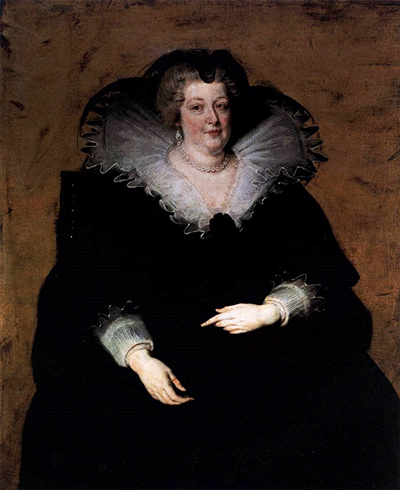Peter Paul Rubens portrait, Marie de Medici Queen of France, is a no frills representation of the widow of the French king, Henry IV.
Painted in 1622, the incomplete nature of the portrait’s background suggests it remained unfinished. The oil on canvas painting would remain with Rubens until his death in 1640 when it was acquired by King Philip IV of Spain and is now housed in the Museo del Prado in Madrid.
The portrait shows Marie de Medici dressed all in black and replete with her widow’s headdress. Henry IV died in 1610 and from then until 1617 Marie de Medici became the regent for her son, the future King Louis XIII. It is a sober representation, one which acknowledges her husband yet emphasis Marie de Medici’s importance as the Queen Mother. She wanted to commemorate her husband and their lives together until his death and this is when Rubens was summoned.
In Autumn 1621 Rubens was commissioned by Marie de Medici to produce a series of 24 paintings which would adorn two galleries at the Luxemburg Palace in Paris. Although this portrait was not part of the series it reflects the patronage Rubens received from her court at this time. Without any background there is nothing to draw the eye away from the subject, France’s Queen Mother.
Rubens was known for his baroque style, using imagery full of grandeur and colour, often emphasising movement. His simple portrait of Marie de Medici feels the exact opposite.
Peter Paul Rubens was a highly influential artist of his time. He combined the realism of his Flemish homeland with the more traditional ideas of the Italian renaissance to evolve his own baroque style. It was during his time in Venice and Rome that Rubens studied and was influenced by artists such as Titian, Caravaggio and Veronese.
Yet Rubens was to become known as the ‘Prince of Painters’ such was the appreciation of the quality of his work among his peers. His is a long lasting legacy, influencing the likes of Picasso and Rembrandt, as well Van Dyck and the landscapes of Constable.
As a diplomat Rubens travelled in Europe and gained access to royal courts. However, he was also recognised as one of the continent’s finest artists. His portrait of Marie de Medici may not have adorned the Luxembourg Palace but his retention of the painting signifies her lasting patronage and friendship. When Marie de Medici was exiled from the French court she would find refuge in Cologne in a house offered to her by Rubens.




